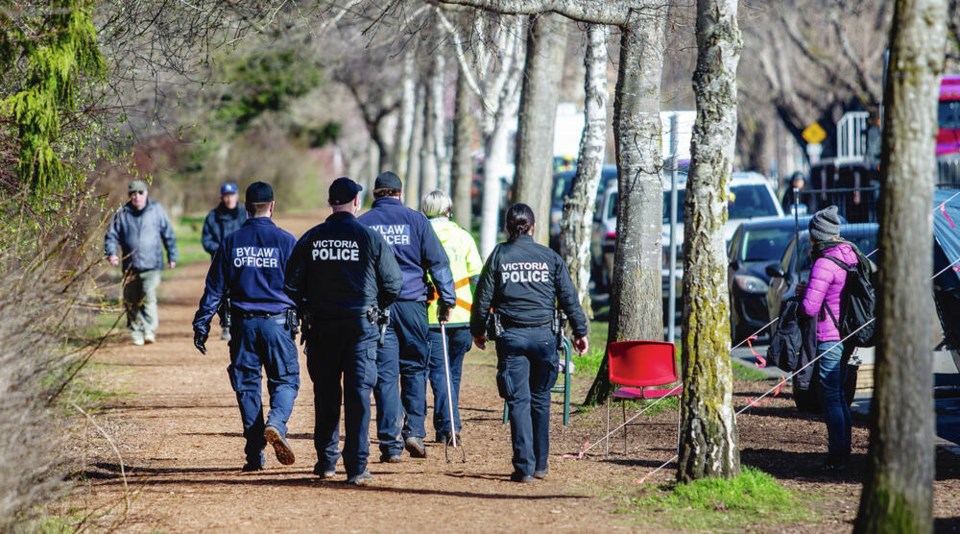A commentary by the past chair of Grumpy Taxpayer$ of Greater Victoria, a citizen’s advocacy group for municipal taxpayers.
Increasing violent criminal activity in recent months highlights the need for a broad-based approach to restore public safety in our wonderful community.
Municipal politicians will be spanked in next year’s election unless they collectively deal with the issue of severe and violent crime.
Little City of Victoria now has a ‘big city’ public-safety problem:
If things are to be turned around, all levels of government and the entire community will need to step forward. The parochial self-interests of any municipality must not rule when dealing with what’s arguably the No. 1 regional issue.
The Victoria and Esquimalt Police Board has recommended councils consider a $4.1-million budget hike and adding 10 more staff members for 2022. They acknowledge that ‘freezing staff levels during the past few years may have proven to be somewhat short-sighted. …’
After several recent assaults on police officers, Victoria Police Chief Del Manak was blunt. “I condemn the alarming level of violence in our community and ask that we all reflect on what makes us a safer community together. The current climate is not acceptable, and should not be acceptable. Anti-police sentiment, disregard for law and order, and disrespect for authority is not a solution.”
Authorities have pointed to a broken bail system as the main reason suspects return to the street to commit additional crimes. Clearly, the so-called catch-and-release approach and “principle of restraint,” brought in by federal legislation Bill C-145 and the B.C. Prosecution Service, need critical examination and reform.
Other initiatives are worth consideration.
Create a regional police force. In 2018, a majority of voters in Victoria and Saanich committed to a citizens assembly process to study the pros and cons of merging the two largest municipalities. As their work gets underway in 2021, a separate background study exploring the impact of creating a regional police force must be a priority. There are eight police departments or detachments to look after 425,000 residents on the South Island. Efficiencies must be found as policing demands and costs increase.
Community safety surcharge. The reputation of the South Island as a safe region needs preserving. Regional taxpayers collectively fund vital services such as sewer treatment and climate change. It’s time to set aside parochial interests and provide additional funds to address public safety issues. After trimming municipal budgets, a modest “community safety surcharge” could raise a few million dollars to perhaps pay for integrated mobile crisis response teams.
Hire auxiliary police. An analysis of 30 years of B.C. police service data found that officers spend 40 per cent of their time on report-writing and other administrative tasks. Savings could be found if administrative and traffic management duties of skilled police officers were farmed out to non-uniform personnel. By one estimate this would amount to an annual savings of 11 to 14 per cent of operating costs. What’s the holdup?
Local politicians, police and unions are right to call for the province to do much more to address community safety.
Build secure, closed institutions. Community supports and drug therapy are all very well, but there are some souls who need a secure facility for their own protection and that of the public. UBCM, mental health and criminal justice authorities have been calling for closed institutions for years. Why is the province not acting on this while communities are destabilized?
Plan another provincial jail. For those who treat criminal laws as a mere suggestion and put public safety at risk, another crowbar hotel is overdue. The medium-security Vancouver Island Regional Correctional Centre was built in 1913, extensively renovated and expanded in 1984. Now, it’s constantly over capacity and continues to be ill-suited during a pandemic. Considering it takes years to bring a new institution to completion and our population is increasing, the province needs to start planning now.
Pay for policing protests. Victoria and Esquimalt taxpayers are unfairly picking up most of the bills for policing an increasing number of political protests at the legislature precinct. In 2017, VicPD managed 14 protests, but in 2020, they managed an unprecedented 66. The legislature provides a measly $50,000 grant annually to help VicPD offset costs. Taxpayers should demand they pay the actual costs, money that could be used to maybe fund foot patrols downtown to help reassure nervous residents and visitors.
Fund more mental health and addiction services. Addressing the underlying problems of mental health and addiction will yield the greatest results. Both have been starved for resources for a generation or more. The stress brought on by the pandemic and opioid crisis has only highlighted the gaps in and growing need for these critical services.
The province’s solution is to try to stabilize the homeless in supportive housing with increased mental health and addictions support. While this so-called “complex care initiative” is promising — it’s not doing great so far — it’s a failure as a standalone solution.
To restore public safety and avoid severe and violent crime becoming entrenched, a multi-pronged approach is critical to arresting our No. 1 regional issue.



